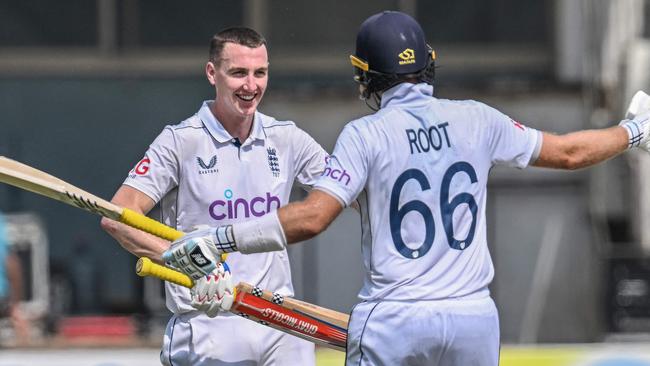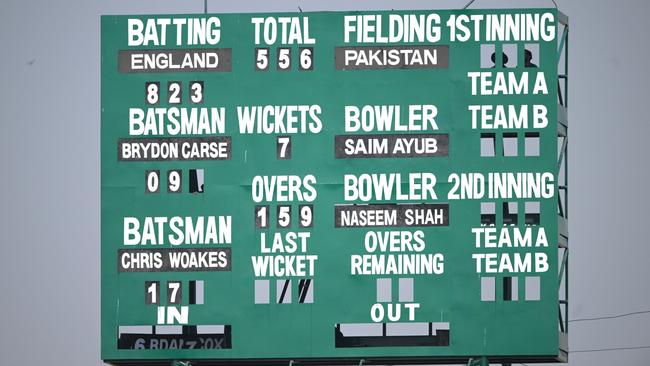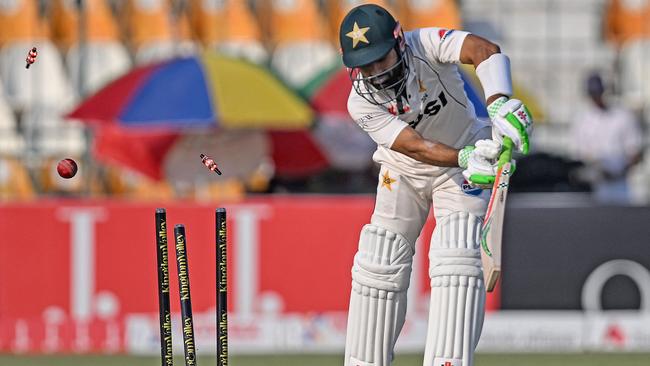Records tumble as England smash 823 against Pakistan
Harry Brook and Joe Root rewrote cricket’s history books as England reached the fourth-highest score in Test history.

On and on he went, this remarkable young Yorkshire batsman. In the scorching heat and suffocating dust of Multan, Harry Brook pushed himself to his physical limits, ticking off, in partnership with Joe Root, record after record, personal milestone after milestone, to become only the sixth England batsman to make a triple hundred in Test cricket. Finally, he could go on no more.
Brook made 317 and Root 262 on a day of blistering batting, during which England declared on 7-823, their third-highest Test score and the fourth-highest made by any team. The pair led England from the field arm in arm at the end of the day, having earlier flogged Pakistan’s bowlers all over the park, and having laid the foundation for a victory push that brought six late wickets to complete an astonishing turnaround.
HARRY BROOK BECOMES THE FIRST ENGLAND PLAYER TO SCORE TRIPLE HUNDRED IN THIS CENTURY. 🙇🔥 pic.twitter.com/U435UiSbjg
— Johns. (@CricCrazyJohns) October 10, 2024
Few would have envisaged Pakistan losing the match having made more than 550 in their first innings, but that is the fate that awaits them now, having buckled to a combination of incisive seam bowling, especially from Brydon Carse, a pitch finally showing some wear and the pressure of a third innings in a high-scoring game. The key was England’s scoring rate: astonishingly they made 267 runs more than Pakistan on first innings in only one extra over, buying them time in the game.
When England’s innings was closed, Pakistan were utterly demoralised, exhausted and out on their feet, victory out of sight. What followed then was a startling collapse, of mind and of spirit and of wickets, of the kind that only the punishing nature of Test cricket can induce. After 1379 runs had been scored over the course of the first two innings, Pakistan were reduced to 6-82, their brains and bodies frazzled by Bazball. Had England not spilled four chances, victory might have been wrapped up within four days.
When Chris Woakes knocked back Abdullah Shafique’s off stump with the first ball of the innings, alarm engulfed the home team, after which Gus Atkinson and Carse followed Woakes’s lead, to reduce the top order to rubble. Signs of panic were all around, not least from Saim Ayub, who played a horrible carve to mid-off, but the dismissals of Babar Azam, caught behind, and Mohammad Rizwan, bowled neck and crop, owed everything to the bowlers’ accuracy, persistence and movement.
The collapse was set up by Brook, who scored a dizzying 176 runs in 149 balls on the day, and who entered elite company midway through the afternoon when he clubbed the part-time bowler, Ayub, down the ground, to join Andy Sandham, Sir Len Hutton, Wally Hammond, John Edrich and Graham Gooch in England’s 300 club. He looked to the heavens when he got there, a nod to his late grandmother, Pauline, who was such an influence on him, and in whose honour he had stepped away from cricket for a while last winter.
But during that short break he had not been idle, putting in some punishing gym work and recalibrating his approach to his nutrition and fitness more generally. The challenge here, on the flattest of all pitches and against a limited attack – made more so by the absence on the fourth day of Abrar Ahmed through illness – was a physical one and he came through that test with flying colours, running hard and relentlessly for his mate Root despite the searing temperatures.

Hutton’s highest Test score for an England player – 364 made in 1938 – was in not-too-distant sight for Brook when he finally made a mistake, top-edging a sweep, but by this stage all of Yorkshire was in clover. That particular record would stay in the county, whether Brook got there or not, and with Root having departed earlier for his highest score in Tests, it was a day when all the glory fell on the Broad Acres.
The White Rose has produced more great cricketers for England than any other county, of course, and the lineage of great batsman from there is a long and proud one. Root is already among that number and Brook will surely become so, and both pencilled their names into the record books when they consigned to history the highest partnership for England in Tests, which had stood since 1957.
England became the first Test team to reach 700 runs while losing just three wickets.
Wondering how exhausted Joe Root must be after his mammoth stint in the middle?
— England's Barmy Army ðŸ´ó §ó ¢ó ¥ó ®ó §ó ¿ðŸŽº (@TheBarmyArmy) October 10, 2024
He’s currently drying his soaking wet kit in the baking Multan sun 😂#PAKvENGpic.twitter.com/GWEJDjSmA8
By the time they were parted they had added 454 for the fourth wicket, not only England’s highest but the fourth-highest in the history of the game. They were good for each other, too, Root benefiting from Brook’s youthful enterprise and more expansive game and Brook from Root’s wisdom and calmness. In the company of others, Brook might have got carried away, or bored, but he was ruthless and greedy here, as all great batsmen must be.
The previous record partnership for England was held by Colin Cowdrey and Peter May, when they kicked away West Indies’ Sonny Ramadhin, who bowled 98 overs in the third innings of that Edgbaston Test in 1957, for a draw. Nothing could have been further from Root and Brook’s mind when they walked to the middle on the fourth morning, all eyes initially on the 64-run deficit and then on the type of lead to make life difficult for a team who had shown recent frailties in the third innings.

Napoleon wanted lucky generals, and there hasn’t been a batsman yet who has not benefited from a touch of luck. As well as being a man of supreme talent and Stakhanovite dedication, Root certainly had the gods on his side at the start of play, when Babar, of all people, dropped a dolly at mid-wicket after Root mis-pulled a short ball in the fourth over. The next ball? Driven sweetly to the cover boundary. Down on his haunches, Naseem Shah, the bowler, could have cried.
Pakistan quickly looked demoralised. Without Abrar, their main spin bowler, Salman Ali Agha, the second-string spinner, hugged a line outside leg stump, but it is impossible to shut down players now, as off spinners once could by bowling a negative line. Modern batsmen such as Brook and Root have too many shots, such as a variety of reverse-sweeps, for that. Pakistan could not stop the flow, and the game got away from them.
The milestones flooded in. With a glide into the leg side, Root went past 200, his sixth double hundred in Tests, one behind Hammond. Brook went past 150 and then beyond his previous highest Test score, 186, made against New Zealand in Wellington two winters ago.
Having never scored a double hundred in first-class cricket, Brook chalked off that aberration 20 minutes before lunch when he pushed Naseem for a single to deep point.

Rarely can a Pakistan attack have looked so impotent, so lacking in hope or inspiration. In the afternoon session, Root decided to bring out the reverse-scoop at last to mark his 250, his second such score in Tests. Brook, accelerating, was hard on Root’s heels and would have, no doubt, beat him to 300, had Root not finally, wearily, played back to Salman. Root, by the way, finished the day at short leg to the spinners, a selfless team player to the end.
There were signs, either side of Brook going to his triple hundred, that Pakistan were done. Saud Shakeel dropped the easiest of chances to reprieve Jamie Smith at long on and at that point one feared the worst for the home team when the declaration came.
What followed wasn’t wholly a surprise. Test cricket can be a cruel, cruel game, although for Brook and Root, who basked in glory on the fourth evening, it has never felt sweeter.
The Times






To join the conversation, please log in. Don't have an account? Register
Join the conversation, you are commenting as Logout